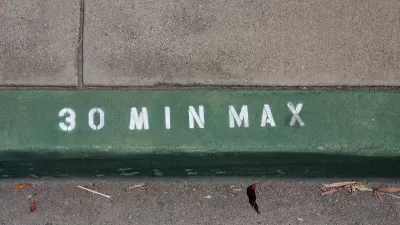SPUR, the San Francisco-based planing think tank, looks at the potential benefits to the public sector of using dynamic, demand-based pricing to manage limited public resources - from parking to electricity.
You're probably familiar with dynamic pricing as it's applied to the shifting cost of individual seats on an airplane, but a market-based approach to better match fixed supplies to fluctuations in demand is slowly catching on in the public sector too, reports Laura Tam. "Sometimes called demand-based pricing or real-time pricing, this is a
more efficient way of allocating publicly provided or regulated goods," says Tam,
"especially those that are subject to wide fluctuations in demand over a
short period of time, such as within an hour or a day. By judging
people's willingness to pay for a publicly provided service - such as
electricity, road space or parking - demand-based pricing enables a more
nimble match-up of supply and demand than has previously been possible. "
With the potential for public benefits in economic efficiency, development of revenue streams, and limiting of environmental impacts, technology is finally making dynamic pricing a possibility for public agencies. According to Tam, "[a] combination of new sensory and computing technologies,
two-way communications and devices that both create and analyze large
volumes of data can now measure and communicate real-time demand. This
information can be used to automate price signals for resources, such as
at smart parking meters. In some cases, it can also be used to remotely
trigger a certain action, such as powering down preselected devices
during periods of peak electricity demand."
Such pricing models are not without their challenges, however, including the potential for higher prices to have a bigger impact on people
with lower incomes. As such, says Tam, "[a]ny demand-based pricing scheme for public goods
must be designed to mitigate disproportionate impacts as much as
possible, especially with goods that were previously 'free.'"
FULL STORY: Smart Cities, Limited Resources

Alabama: Trump Terminates Settlements for Black Communities Harmed By Raw Sewage
Trump deemed the landmark civil rights agreement “illegal DEI and environmental justice policy.”

Planetizen Federal Action Tracker
A weekly monitor of how Trump’s orders and actions are impacting planners and planning in America.

The 120 Year Old Tiny Home Villages That Sheltered San Francisco’s Earthquake Refugees
More than a century ago, San Francisco mobilized to house thousands of residents displaced by the 1906 earthquake. Could their strategy offer a model for the present?

In Both Crashes and Crime, Public Transportation is Far Safer than Driving
Contrary to popular assumptions, public transportation has far lower crash and crime rates than automobile travel. For safer communities, improve and encourage transit travel.

Report: Zoning Reforms Should Complement Nashville’s Ambitious Transit Plan
Without reform, restrictive zoning codes will limit the impact of the city’s planned transit expansion and could exclude some of the residents who depend on transit the most.

Judge Orders Release of Frozen IRA, IIJA Funding
The decision is a victory for environmental groups who charged that freezing funds for critical infrastructure and disaster response programs caused “real and irreparable harm” to communities.
Urban Design for Planners 1: Software Tools
This six-course series explores essential urban design concepts using open source software and equips planners with the tools they need to participate fully in the urban design process.
Planning for Universal Design
Learn the tools for implementing Universal Design in planning regulations.
Clanton & Associates, Inc.
Jessamine County Fiscal Court
Institute for Housing and Urban Development Studies (IHS)
City of Grandview
Harvard GSD Executive Education
Toledo-Lucas County Plan Commissions
Salt Lake City
NYU Wagner Graduate School of Public Service





























